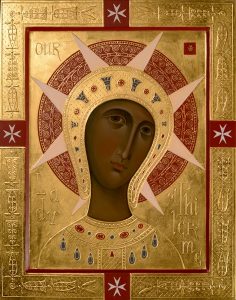OUR LADY OF PHILEREMOS
 When the Knights Hospitaller of St. John of Jerusalem were driven from
the Holy Land by the Muslims, they eventually emigrated to the island of Rhodes in the
Mediterranean in the early 14th century. There they found, on Mount Phileremos,
a chapel dedicated to Mary under the title of Our Lady of Phileremos (also called "Philermos"). Within the chapel
was an icon of Our Lady of Phileremos, said to have painted by St. Luke the Evangelist,
the "Painter of the Virgin." The icon was very antique and has been in this
place since time immemorial. Local tradition has handed down several accounts of different
miracles attributed to Our Lady under this title.
When the Knights Hospitaller of St. John of Jerusalem were driven from
the Holy Land by the Muslims, they eventually emigrated to the island of Rhodes in the
Mediterranean in the early 14th century. There they found, on Mount Phileremos,
a chapel dedicated to Mary under the title of Our Lady of Phileremos (also called "Philermos"). Within the chapel
was an icon of Our Lady of Phileremos, said to have painted by St. Luke the Evangelist,
the "Painter of the Virgin." The icon was very antique and has been in this
place since time immemorial. Local tradition has handed down several accounts of different
miracles attributed to Our Lady under this title.
The founder of the chapel had been a rich man, who climbed up the hill to a place where the ancient Phoenicians had built a temple to one of their solar divinities, which lay in ruins. For reasons unknown to us, he climbed the hill to commit suicide. There, on this hill haunted by the demons of paganism, the desperate man was about to carry out his reprehensible plan, when "a Lady, all bathed in white light," appeared to him; and by the gentleness of her smile and the imparting of heavenly grace, the man had a complete change of heart. Converted and repentant, he chose to live on the spot where Our Lady appeared to him. And here it was that he built a chapel in her honor and enthroned in a place of veneration the icon of Our Lady that he had brought from Jerusalem.
Veneration of the icon spread quickly over the island and the population used to visit it piously. Its fame as a wonder-working image became well known all over the Aegean.
As soon as the Knights arrived, they became very devoted to Our Lady of Phileremos, whose name became their war cry. They built a large monastery next to the chapel and two new chapels were added to the sanctuary by Grand Master, Pierre D'Aubusson after the siege of 1480, in thanksgiving to Our Lady of Phileremos from preserving them from the Muslim attackers. When, at length, they were finally forced off the island by the Muslims, they took their "most precious possession" with them.
When the departing fleet got under way, with only a few surviving Knights aboard, no standard was hung, except one banner on the ship of the Grand Master, the banner of Our Lady of Phileremos, with these simple words: "In my misfortune, Thou art my hope."
Visit also: www.marienfried.com
